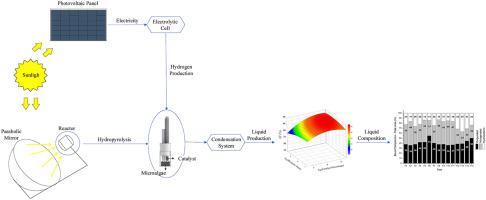Biomass & Bioenergy ( IF 6 ) Pub Date : 2021-07-15 , DOI: 10.1016/j.biombioe.2021.106183 Raíssa Aparecida da Silveira Rossi 1 , Janaína Miranda Barbosa 2 , Marcos Antonio de Souza Barrozo 1 , Luiz Gustavo Martins Vieira 1

|
Hydrogen (H2) and bio-oil production from renewable sources are promising technologies in the energy sector. Particularly, the use of microalgae as a biomass source in the catalytic pyrolysis process in a hydrogen atmosphere is an encouraging approach in the production of high-quality bio-oil. This study combines two forms of harnessing renewable energy: (1) production of H2 through alkaline electrolysis with sunlight as the energy source, and (2) the production of bio-oil through catalytic hydropyrolysis of microalgae using solar energy as a thermal source in biomass degradation. The effects of catalyst (hydrotalcite precursor) percentage (C) and reaction time (t) on the product distribution and bio-oil content are analyzed. An average bio-oil yield of 45.77% is achieved using ex situ catalytic solar hydropyrolysis, which reaches up to 48.83% under optimal experimental conditions. The hydrogen atmosphere contributes to reducing oxygenated compounds and using a catalyst reduces nitrogenous compounds and raises the hydrocarbon level in the liquid fraction. The bio-oil composition is found to reach 37% of hydrocarbons.
中文翻译:

莱茵衣藻微藻的催化太阳能水解
从可再生资源生产氢气 (H 2 ) 和生物油是能源领域的有前途的技术。特别是,在氢气气氛中的催化热解过程中使用微藻作为生物质来源是生产高质量生物油的一种令人鼓舞的方法。本研究结合了两种利用可再生能源的形式:(1)以阳光为能源通过碱性电解生产 H 2,以及 (2) 通过使用太阳能作为热源的微藻催化加氢热解生产生物油。生物质降解。分析了催化剂(水滑石前体)百分比(C)和反应时间(t)对产物分布和生物油含量的影响。平均生物油产率为 45.77%非原位催化太阳能水解,在最佳实验条件下可达48.83%。氢气气氛有助于减少含氧化合物,使用催化剂减少含氮化合物并提高液体馏分中的烃含量。发现生物油成分达到 37% 的碳氢化合物。


























 京公网安备 11010802027423号
京公网安备 11010802027423号